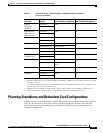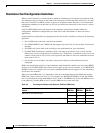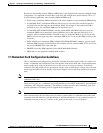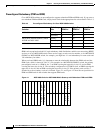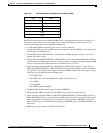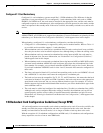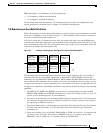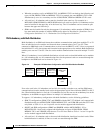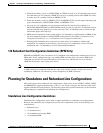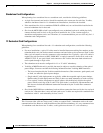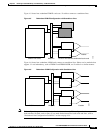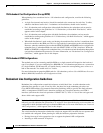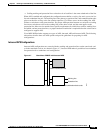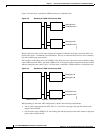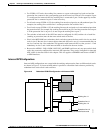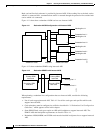
4-11
Cisco MGX 8800/8900 Series Hardware Installation Guide
Releases 2 - 5.2, Part Number OL-4545-01, Rev. H0, May 2006
Chapter 4 Planning for Card Redundancy, Line Redundancy, and Bulk Distribution
Planning for Standalone and Redundant Line Configurations
• When the secondary card is an AUSM, FRSM, or CESM, all cards in a 1:N redundant card set must
be of the same type. For example, a FRSM-8T1 can act as a standby card for other FRSM-8T1 cards;
it cannot serve as a standby card for an MPSM-8-T1E1.
• When the secondary card is an MPSM-8-T1E1, the MPSM-8-T1E1 can back up the following card
types simultaneously: AUSM, FRSM, CESM, and MPSM-8-T1E1.
• All cards in a 1:N redundant card set must be installed in the same bay. For example, in a
MGX 8850 (PXM1E/PXM45) or MGX 8850/B switch, all cards in a specific 1:N redundant card set
must be installed in the upper bay or in the lower bay. The 1:N redundant card set cannot be split
between the upper and lower bays.
• SRMs must be installed in each bay that supports 1:N redundancy, and the number of SRMs in that
bay must match the number of installed PXMs and be placed as described in “Standalone Card
Configuration Guidelines” or “1:1 Redundant Card Configuration Guidelines.”
• Enabling bulk distribution does not prevent you from using 1:N redundancy without bulk
distribution. For example, in the same bay you can set up a 1:N redundancy card set with bulk
distribution and a 1:N redundancy card set without bulk distribution.
1:N Redundant Card Configuration Guidelines (RPM Only)
RPM-PR and RPM-XF cards can operate in 1:N redundant card configurations without the services of
SRM cards. In this configuration type, one standby RPM card takes over if any active RPM in the
redundant card set fails. For more information, refer to the Cisco MGX Route Processor Module
(RPM-PR) Installation and Configuration Guide.
Note If RPMs are installed with backcards, then the active and standby RPM backcards need to have ethernet
or POS connectivity established such that the active cards and the standby card have the same IP
reachability. Otherwise, IP connectivity can be disrupted by an RPM switchover.
Planning for Standalone and Redundant Line Configurations
Most cards support only standalone line configurations. Some cards, such as PXM1E, AXSM, VXSM,
and SRME/B also support redundant lines. Table 4-1 lists all the card types and indicates which cards
support redundant line configurations. The following subsections provide information you need to know
when planning for standalone and redundant line configurations.
Standalone Line Configuration Guidelines
Standalone line configurations can be used to support standalone or redundant card configurations.
However, the standalone line configuration you use will be dependent on one of the following card
configurations:
• Standalone card
• 1:1 redundant card
• 1:N redundant card (except RPM)
• 1:N redundant RPM



